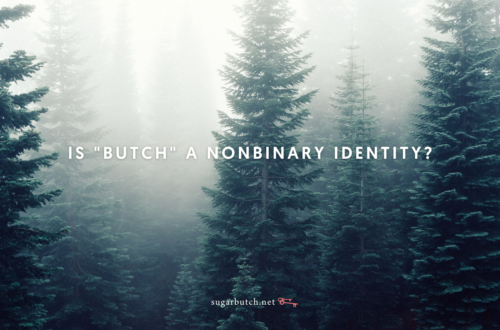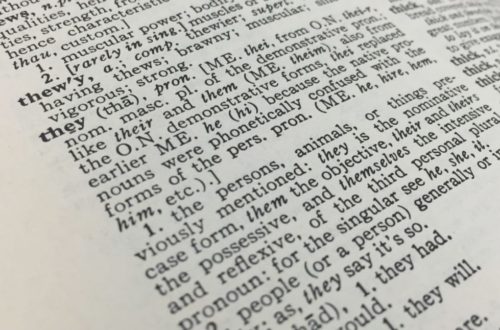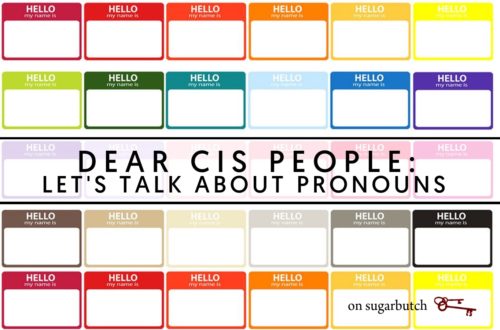This site contains explicit writings on kink practices, dominant/submissive relationships, and queer kink erotica (among other things). All characters in role play or non-consent scenes are consenting adults. Content warnings are included.
On Gina Mamone’s mini-interview, a commenter named MS wrote: “Can you post a definition of or primer on what gender queer means?” Kyle Jones was kind enough to comment in reply and explain a bit, and I proceeded to ask him to write up his own primer on genderqueer. Here it is.
This is a guest post from Kyle Jones, Butchtastic.net
Genderqueer people, by definition, are united by their rejection of the notion that there are only two genders.
Beyond their rejection of the gender binary as the sole way to describe gender, there is much diversity within the group of people who call themselves ‘genderqueer’—it’s a catch-all term that includes sometimes contradictory identifications. For example, some genderqueers identify as neither male nor female, some as both male and female. Some see ‘genderqueer’ as a gender in and of itself, some may identify this way because they feel they are beyond gender—genderless or a-gender.
I led a discussion on genderqueer identity at Butch Voices Portland 2010 and almost everyone who attended came to this identity from a different place. There were those who described a fluidity of gender, a sense that they were a mixture of male and female. Some people wanted to move beyond the terms ‘male’ and ‘female’ entirely. They didn’t see genderqueer as being a region along the gender binary axis, instead many described it as independent of that spectrum. Based on the diversity of personal definitions expressed in that session, we started to talk about a gender cloud rather than a gender spectrum. Because ‘genderqueer’ is an umbrella term, to really know how an individual relates to it, you’ll need to know their personal definition of genderqueer.
The term “genderqueer” can also be used as an adjective to refer to any people who transgress gender, regardless of their self-defined gender identity. And some genderqueer individuals also identify as transgender, because their gender identity does not completely correspond to their physical sex. Genderqueers may have any sexuality/sexual identity, any physical sex. There is also diversity in the way genderqueers relate to pronouns. Some prefer gender neutral pronouns such as ‘they’ or ‘them’ or the alternate forms “ze,” “per,” “sie” and “hir,” “zhe,” “hir.” And some prefer to stay with traditional male and female pronouns, though they may use them in less traditional ways. Other terms similar to genderqueer are genderfluid, gender-variant, bi-gender, third gender, two-spirit and gender non-conforming.
If you find all of this a bit confusing, you’re not alone. When I come out to people as genderqueer, I’m more surprised to find people who are familiar with the term than those who aren’t. And when I’m asked to define genderqueer, as I was for this article, I find it challenging, especially with people who aren’t comfortable or experienced in considering gender beyond male and female. In my experience, most of the world is still not ready to go beyond the gender binary. It takes a lot of work and effort to learn the new vocabulary and open your mind to alternative ways of seeing gender. One challenge I still have is trying to get my head around the idea of being ‘genderless’. I know that much of the way my brain has organized information about the world is still ruled by the existence of distinct genders.
As I mentioned, I identify as genderqueer. Butch describes my appearance, genderqueer describes my gender and queer describes my sexuality. My personal genderqueer definition is that I am not male or female, I am male and female. I have two distinct gender identities, each with a name, a set of pronouns and sexual preferences. Sometimes the distinction is obvious and sometimes more fluid and combined. One visualization I use is that of a tree with two trunks, each coming from the same root structure and base. My male and female identities have some shared history as well as some that is separate. As I visualize my ‘tree trunks’, they start together, then grow apart, come close again, intertwine and grow together, then diverge again as you look up the tree. My male side has a distinct personality, accent, sexual drive and issues. It has also been suppressed more, being less accepted by the outside world and, as a result, is the less developed and mature of my two identities. My female side, having had more time at the forefront, takes the lead in most situations, although my goal is to become more balanced.
You may be thinking, this person has multiple personality disorder. Though I’m not a professional, I know that’s not the case. I have multiple genders, which means I also identify as transgender, because the male side of me does not match my female body. I’ve had some awesome and unexpected experiences lately where strangers have seen my male side. It’s hard to describe the feeling of being recognized and acknowledged as male—something like a rush of adrenaline combined with a strong sexual charge—a big ol’ ego boner.
This is a frustration I share with other genderqueer and transgender people—the feeling of being partially invisible, of spending most of my days being partially unseen. I think we all share a common need to be seen and celebrated for who we truly are, and not just the easily understood fragments, but all our wonderful complexity.
This article is meant to be a starting point for people new to the term ‘genderqueer’, but it’s by no means the last word. If you’d like to learn more about variant gender identities, here are some excellent starting places:
- List of blogs by Butch, Genderqueer and Trans authors on Butchtastic.net
- Beyond the Check-boxes: Exploring Genderqueer Identity, hand-out for my session at Butch Voices Portland 2010.
- Wikipedia: informative and non-judgmental articles on a wide variety of gender and identity topics:http://en.wikipedia.org. Source of some of the definitions above.
- Transifesto, Trans-lations page: Matt Kailey’s list of terms used often on his blog, relating to sex and gender. Source of some of the definitions above.
- Polygender.co.uk: resource pages with information on genderqueer and transsexual related topics.
- Gender Queer. Voices From Beyond the Sexual Binary, Joan Nestle, Clare Howell, Riki Wilchins (2002) Alyson Books, New York.
- Gender Outlaw: On Men, Women, and the Rest of Us 1994, Kate Bornstein
- My Gender Workbook: How to Become a Real Man, a Real Woman, the Real You, or Something Else Entirely 1997, Kate Bornstein
- Gender Outlaws: The Next Generation, 2010, Edited by Kate Bornstein and S. Bear Bergman
Kyle Jones runs Butchtastic.net and was interviewed on Butch Lab earlier this year.




This is a wonderful piece and resource list, Kyle. Your openness and desire to live authentically, even when you have to create new definitions for yourself, is inspiring. Thank you for sharing your truth.
This is a fantastic resource, and I thank you for it.
One quick question: If the goal of identifying as genderqueer is to challenge the gender binary, is there a way to talk about gender that goes beyond identifying as “both genders” or beyond having “two distinct gender identities”?
Jenna,
Great question. I’m confident that there are people much farther along than I am in terms of getting beyond gender entirely. In general, I think gender terminology can still be helpful in bridging the distance between the traditional ways of defining gender and the new ways that are being explored now. In some cases, new words and terms are being created all the time but the majority of people I interact with on a regular basis aren’t keeping up.
I specifically choose to define myself and my dual identities in terms of gender because it’s the clearest way I have of explaining myself at this time. I am completely open to finding new terms, that’s why I want to promote conversations like this one. I want to learn from what others have found in their explorations outside the gender binary.
I’m confident that you could talk to a group of people who identify as genderqueer and each would have a slightly different way of describing themselves and relating to gender, or non-gender. I define myself as having distinct identities based on gender but I have no evidence that my personal definition is typical, or atypical, for that matter. I haven’t met enough genderqueers to know yet if there is a typical genderqueer self-definition.
Thanks for the question, Jenna. I’m really into discussions and explorations of gender, and I appreciate you taking the time to participate in the conversation.